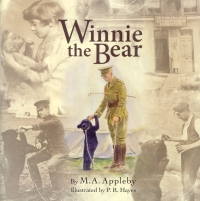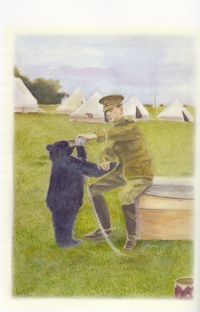| ________________
CM . . . . Volume XVIII Number 31 . . . . April 13, 2012

 |
Winnie the Bear.
M. A. Appleby. Illustrated by P. R. Hayes.
Winnipeg, MB: Dominion Street Publishing (445 Dominion St., R3G 2M8), 2012.
137 pp., hardcover, $34.95.
ISBN 978-0-9878212-0-1.
Subject Headings:
Winnie (Bear).
Coleburn, Harry, 1887-1947.
Black bear-Biography.
Human-animal relationships.
World War, 1914-1918-Veterinary service.
Milne, A. A. (Alan Alexander), 1882-1956. Winnie-the-Pooh.
Shepard, Ernest H., 1879-1976.
Winnie-the-Pooh (Fictitious character).
Grades 5 and up / Ages 10 and up.
Review by Harriet Zaidman.
*** /4
|
| |
|

excerpt:
You can’t be in London for a long time without going to the Zoo… but the nicest people go straight to the animal they love the most, and stay there. So when Christopher Robin goes to the Zoo, he goes to where the polar bears are and whispers something to the third keep from the left, and doors are unlocked, and we wander through dark passages and up steep stairs, until at last we come to the special cage, and the cage is opened, and out trots something brown and furry, and with a happy cry of “Oh, Bear! Christopher Robin rushes into its arms.”
Winnie the Pooh is an iconic figure for children, thanks to the gentle stories crafted by A. A. Milne in the 1920s, the playful illustrations by E. H. Shepard and, of course, Walt Disney. His 1966 animation, with Sterling Holloway first giving voice to Winnie, ensured the bear and his love for honey has a place in our hearts even as we become adults.

The imaginary Winnie’s origins lie in a real bear that lived in the London Zoo, a locale to which Milne took his son, Christopher Robin Milne, for outings. It was only in the 1980s, however, that the real bear’s origins were traced back to White River, ON, where she was purchased as a cub by Captain Harry Colebourn on his way to Britain to serve as a veterinarian for horses used in World War I. It was also discovered that Colebourn named her Winnie after his adopted hometown of Winnipeg, MB.
This interesting revelation came about through a casual conversation between Harry’s son, Fred, and author Mary Ann Appleby’s father, Bill. Over the years, the idea for a book grew in her mind. When she was ready, her investigations took Appleby on a voyage through history – of the Colebourn family and its immigration to Winnipeg, of the horrors of World War I, of A. A. Milne and his son Christopher, and her own family and its connection to Britain and the Colebourns.
Appleby has woven all these stories into this interesting and tastefully designed self-published volume which is beautifully illustrated by P. R. Hayes. He evokes the era of Britain in World War I and after with quiet watercolours and sketches. Sepia-toned entries from Colebourn’s diary dot the text, and an appendix of photographs traces the story from Colebourn’s family in Britain through to the unveiling of the statue of the soldier and his unusual pet at Assiniboine Park in Winnipeg in 1992.
Appleby has written a reflective and endearing account of Winnie, and the stories that surrounded her. Winnie the Bear is the type of book to be read casually, to be dipped into and thought about, picked up in quiet moments. Appleby’s own story is a thread drawing the various parts together. She has done extensive research that will educate readers about Colebourn, the Canadian forces that crossed the Atlantic to serve the British Empire’s cause, the carnage that World War I (supposedly the War that would end in three months), all about bears, and all about A. A. Milne and the fallout from the massive success of his stories. Appleby deals with each topic thoroughly in a simple, warm style.
Readers will find the story about Milne interesting, especially because of the effect on his son, on whom the child-character was based. Christopher Milne felt stigmatized by the character, frozen in time. He chose the life of a bookseller in a town in England, but he felt he was never allowed to grow up. He said he felt “that my father had got to where he was by climbing upon my infant shoulders, that he had filched from me my good name and had left me with nothing but the empty fame of being his son.” Christopher Milne was an only child, yet he did not accept the benefits of his father’s estate. Christopher’s own daughter had been born with cerebral palsy, and he directed his inheritance to her to ensure her financial security.
Winnie was, according to the zookeeper and the newspapers, a gentle and safe animal. A. A. Milne wrote, “The bear hugged Christopher Robin, and they had a glorious time together, rolling about and pulling ears and all sorts of things,” when his son was allowed into the enclosure. Winnie was fond of condensed milk and ‘hummed’ when she was content. She also rocked back and forth and, again according to her keeper, did a “daily dozen” – a series of exercises consisting of physical jerks (which Milne adapted in to Winnie-the-Pooh’s “stoutness exercises”).
The one failing of this book is Appleby’s inability to address the treatment of animals at that time - the narrow confines that produced rhythmic repetitive habits, the unhealthy diet they were fed. It was lucky for Christopher, the zookeepers and other visitors to Winnie’s cage that she didn’t go stir crazy and attack anyone who opened the door. She was a black bear, after all. It was the way animals were treated then (and, despite public awareness, still are, in older zoos around the world). It was based on the notions of human superiority, objectivism toward the animals and lack of knowledge. It would have been sensible to address the issue of the mistreatment of animals that animal activists have raised for decades and which zoos themselves have acknowledged and addressed. Today’s children would expect an explanation.
Still, Appleby’s book offers much that can be appreciated. Pre-adolescents, teens and adults will appreciate the informative and well-written stories, the well-rounded presentation of history and the personal narrative that gives this book its warmth and sense of connection.
Recommended.
Harriet Zaidman is a teacher-librarian in Winnipeg, MB.

To comment
on this title or this review, send mail to cm@umanitoba.ca.
Copyright © the Manitoba Library Association. Reproduction for personal
use is permitted only if this copyright notice is maintained. Any
other reproduction is prohibited without permission.
NEXT REVIEW |
TABLE OF CONTENTS FOR THIS ISSUE
- April 13, 2012.
AUTHORS |
TITLES |
MEDIA REVIEWS |
PROFILES |
BACK ISSUES |
SEARCH |
CMARCHIVE |
HOME |

